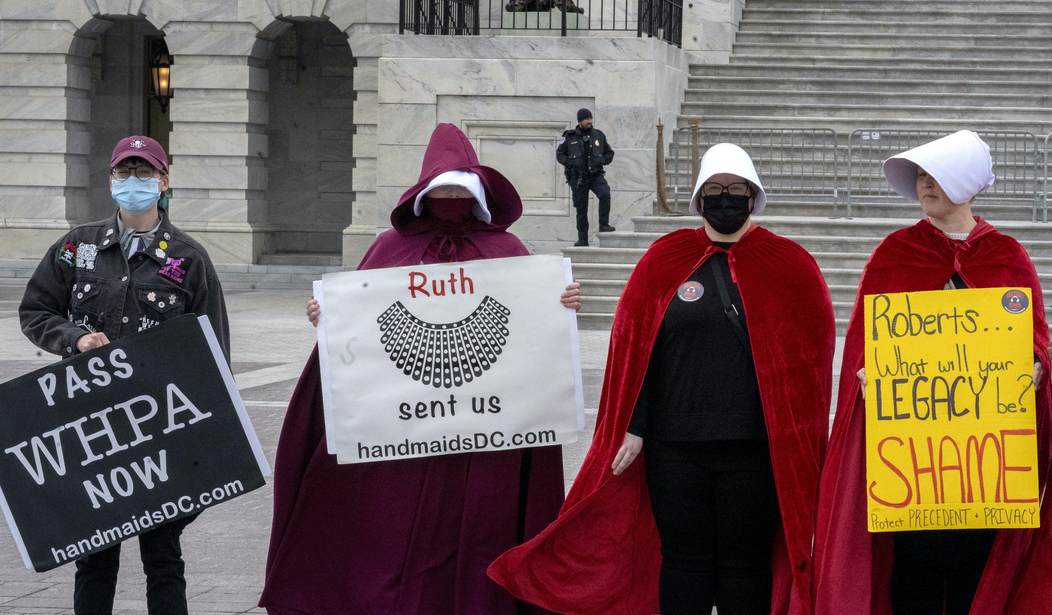Will the end of Roe recast the elections in November? According to the New York Times, it might not have even made much of a difference in June. Despite polls over the weekend showing spikes of Democratic voter enthusiasm after the Supreme Court vacated Roe in their Dobbs decision on Friday, by Tuesday voter turnout looked “typically sluggish,” at least in the early going:
The Supreme Court decision ending the constitutional right to abortion was expected to motivate voters. Turnout in several states hosting primaries on Tuesday, however, appeared to be typically sluggish — at least so far.
All of those states have various forms of early voting, meaning that many ballots may have been cast before the court struck down the landmark Roe v. Wade case on Friday.
True, but that misses an important point. Thanks to an unprecedented (and highly unethical) leak from the Supreme Court on May 3, voters have known or at least strongly suspected that a majority on the Supreme Court had decided to toss out Roe and hand abortion back to the states. Early voting may have started before that point in yesterday’s primaries, but perhaps only just. At the least, almost all of this voting period for yesterday’s primaries took place in the knowledge or at least strong suspicion that Roe was toast.
And yet, not much changed anywhere, at least from the early indicators of turnout. Not even in New York did voters thunder to the polls in protest of the Supreme Court’s action, where one might expect a more impassioned response to it. Most people couldn’t be bothered, not even when the Republican race turned out to be competitive:
Turnout in the Democratic and Republican primaries was anemic across New York City during the first full-fledged gubernatorial primary since the rollout of early voting, according to stats from the Board of Elections.
Just 87,000 of the 3.6 million registered Democrats and Republicans cast ballots during the nine days of early voting that preceded Tuesday’s primary — an abysmal turnout rate of just 2.4 percent, the figures fro the city BOE show.
Turnout among Democrats was slightly better than average at 2.6%, even though Gov. Kathy Hochul is heavily favored to beat her primary challengers in today’s voting. Just 1.4% of GOP voters cast ballots in advance in their four-way contest to challenge Hochul in November.
“It seems to be endemic, people just aren’t interested in it except when you have a real race,” said Doug Muzzio, a political science professor at CUNY’s Baruch College. “And most races have been — to be honest — snoozes, and this one is similar.”
The same is true in Illinois, the NYT reports, as well as in Utah and Colorado. All of those states featured not just competitive races but bitterly fought contests. Democrats spent several million dollars meddling in GOP primaries in Colorado and Illinois, about which more later, and abortion was very much in the middle of those campaigns. In Illinois, voters were barely waiting to get inside, the NYT notes. Matt Dietrich predicted turnout would hit around the average of 27% for midterm primaries, and said, “It’s going to look slow all the time.”
The only evidence of a Roe-related turnout came from Nebraska, the Associated Press reports, and it was both indirect and insufficient. A special election to replace convicted House Republican Jeff Fortenberry in NE-01 turned unexpectedly close, the Associated Press reports. In the R+11 district, Republican Mike Flood only held off Democratic nominee Patty Pansing Brooks by four points. The difference appears to have come from a drop of Republican support in urban Lancaster County, but ….
The specific cause of the margin wasn’t immediately unclear, although there was evidence of higher turnout in one Democratic-leaning county that could be related to the Roe decision.
Heading into election day, Flood appeared to have a strong edge in the district, which includes Lincoln, parts of suburban Omaha and dozens of smaller, more conservative towns. The district has nearly 68,000 more Republicans than Democrats and hasn’t elected a Democrat to the House since 1964.
What happened? Lancaster County, home to the state capital and the University of Nebraska, offers some clues.
In 2020, Fortenberry won the district by nearly 22 percentage points, but he lost Lancaster County by less than 1 percentage point. In Tuesday’s special election, the Republican Flood lost Lancaster County by more than 13 percentage points.
Special elections are special cases of turnout, but even that aside, other factors are in play here. The scandal around Fortenberry likely made Republican voters less motivated to turn out, especially in Lancaster County. We don’t know whether Flood lost votes due to that, or to abortion politics, or both. Given the lack of enthusiasm in other regularly scheduled primaries elsewhere, it seems more likely that we’re looking at a Fortenberry effect rather than a Roe impact.
But even if it was largely an abortion issue, it didn’t move the needle enough to matter in Nebraska, and that’s just four days after the Dobbs decision made the Roe revocation final. If it didn’t move the needle this week, it’s highly unlikely to move the needle in November. This midterm cycle will still hinge on the economy, inflation especially, crime, and the referendum on the incumbent president. Democratic scaremongering on abortion won’t distract from the daily lived experience of American voters over the next four months — and in fact, it doesn’t even appear to have lasted four days.







Join the conversation as a VIP Member